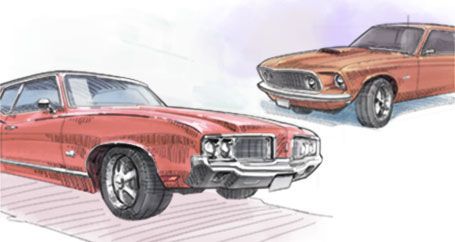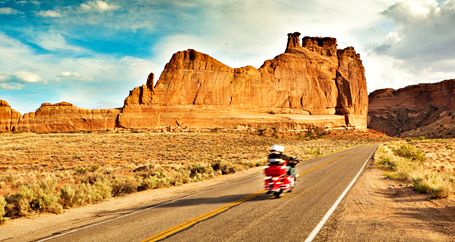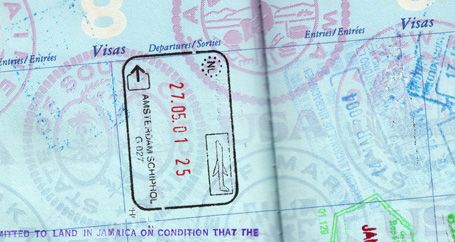It was 9 a.m. on a Friday, and I was having breakfast with an old friend. He asked, “So, what are you going to do today?” I said I didn’t know, and I meant it. Then I said, “Ya know, I’ve never been to Miami. How far is it from here?” We looked. Twelve hours. I figured, Eh, might as well. I woke up the next day surrounded by palm trees and questionable tans.
As a freelance journalist, I’ve been lucky enough to work from wherever I have Internet access. In July 2015, I decided to push that concept to the next logical extreme. I gave up my apartment, sold a bunch of stuff and bought a big conversion van (i.e. a Class B RV). I’ve been on the road full-time, driving around the U.S. and Canada for more than 21 months.
The first rule of road trips: come home in one piece. That means you, your RV and your stuff. When you’re on the road in an RV for 21 months (and counting), you learn a lot—from dealing with roadside emergencies to gearing up for maximum comfort on wheels. Here’s a rundown of what I wish I’d known when this epic road trip started.
I Bought a Camera That Gives Me Eyes in the Back of My Van
Because my van’s rear windows are obscured by the bed, and the RV doesn’t have a rear-view mirror, a backup camera is one of the first things I installed. Before the camera, every time I backed up, I would do it inch-by-inch, always anticipating a scream or a crunch.
Backup cameras typically come standard with new RVs, but if you’re in a used van (like me), you can buy wired or wireless cameras. I went wireless because running 22 feet of cable behind the internal paneling seemed like a nightmare. Other RVers say wired cameras are more responsive and may be more reliable, but I have no complaints about my wireless.

I Bought a Camera That Gives Me Eyes in the Back of My Van
Because my van’s rear windows are obscured by the bed, and the RV doesn’t have a rear-view mirror, a backup camera is one of the first things I installed. Before the camera, every time I backed up, I would do it inch-by-inch, always anticipating a scream or a crunch.
Backup cameras typically come standard with new RVs, but if you’re in a used van (like me), you can buy wired or wireless cameras. I went wireless because running 22 feet of cable behind the internal paneling seemed like a nightmare. Other RVers say wired cameras are more responsive and may be more reliable, but I have no complaints about my wireless.

These cameras do not “see” well at night, so pay attention to product reviews about how any system you’re considering buying performs in the dark. Infrared L E Ds help with night vision, and some cameras are equipped with as many as eight. Roof-mounted cameras (versus those that mount at your license plate) also allow you to see the rear bumper when backing up.
I went with a camera that feeds directly into my double-D I N stereo system’s display screen. (A D I N is the opening where the radio fits in a car’s console. Single-D I N receivers are 7” x 2”; a double-D I N is 7” x 4”. And, in case you were wondering, DIN stands for Deutsches Institut für Normung, the German standards organization responsible for creating the original standard size for car head units in 1984.) Other cameras require installing a small screen, which may or may not be included. I recommend looking for one that’s big enough to easily view, which means five inches or larger, and has high brightness and low reflectivity.
8.9 million
The number of RV-owning households in the U.S. —Recreational Vehicle Industry Association
Why I Installed a “Sense of Security” System
I did very little planning for this trip, which has made the whole thing feel more like an adventure. But it also means I occasionally pull into an unfamiliar town in the middle of the night looking for a place to sleep. As a result, I’ve slept in a few questionable places. Installing an alarm system has given me peace of mind when I’m away from the RV and when my instincts tell me I’m not in a great spot.
When it’s armed, my system sounds an alarm when it detects the crash of glass (also, oddly, when it detects that I’ve sneezed). I had a car-stereo specialist install a higher-end system ($400 for the system, $100 per year for the service) because it offers remote notifications and GPS. I could be on the other side of the country, but if my van’s alarm goes off, my phone will ring and I can have somebody check on it. I can also lock and unlock it remotely, which has come in handy. Once, I had to leave the van at an airport’s long-term parking garage for a week. I checked the system with my phone and saw the attendant left it unlocked, with all my belongings inside. I was able to lock it and set the alarm with a few taps on my phone.
How to Keep the Important Stuff Safe
I sacrificed one of my precious few cabinets for a steel safe because I travel with expensive gear. I gutted the cabinet, bolted thick plywood to the van’s frame and bolted the safe to the plywood, which makes it extremely difficult to remove (and my alarm should be shrieking the whole time). My safe came with a fingerprint scanner, which didn’t add much to the price and allows me to easily open it in the dark. It’s big enough for my computer, hard-drives, cameras and important documents, like my passport. If you’re researching safes to buy, make sure the biggest item you’ll be locking up will fit through the door; the exterior dimensions will be larger than the actual door opening.

How to Keep the Important Stuff Safe
I sacrificed one of my precious few cabinets for a steel safe because I travel with expensive gear. I gutted the cabinet, bolted thick plywood to the van’s frame and bolted the safe to the plywood, which makes it extremely difficult to remove (and my alarm should be shrieking the whole time). My safe came with a fingerprint scanner, which didn’t add much to the price and allows me to easily open it in the dark. It’s big enough for my computer, hard-drives, cameras and important documents, like my passport. If you’re researching safes to buy, make sure the biggest item you’ll be locking up will fit through the door; the exterior dimensions will be larger than the actual door opening.


Find out more about how
I turned my RV into a
powerful workspace and
comfortable home.
Read more about road trips
Why All Roadside Service Plans Are Not Created Equal
One month into my trip, I broke down in the middle of nowhere in Oregon. The flatbed that showed up couldn’t load my van without scraping the tailpipe, so we spent a full, stressful hour shimming it with two-by-fours. And my emergency roadside coverage wouldn’t get me all the way to an RV repair center, so the tow truck operator hauled me to his buddy’s shop. I spent the night in a desolate parking lot, where a suspicious guy made repeat visits to idle next to my van. I didn’t sleep.
This was my lesson-learned-the-hard-way in getting an emergency roadside assistance plan specifically for RVs. Many roadside plans only cover the first 20 miles of towing; if you’re traveling in an RV, you may be hundreds of miles from a repair shop capable of working on an RV. Some towing companies aren’t equipped to deal with larger rigs, too. A dedicated RV roadside provider should be best equipped to locate the nearest tow truck operators and repair shops to work on your RV. My service costs about $80 a year and it covers towing to the nearest RV service center with no mileage limit and includes extras like jumpstarts and tire repair.
It Helps to Have Inspiration
I call my RV Ashley the Beast. When I first saw this big van, I thought, “Dang, she’s a beast!” Not long after buying it, one of my best friends, named Ashley, was diagnosed with stage IV metastatic breast cancer. It had already spread to her spine and both femurs. But she was like, "I've got this." She'd go to chemo, then do a CrossFit class. Do radiation, then run a 5K. I’d tell her, "You're such a beast!" She's a beast, the van is the beast—so the van became Ashley (a.k.a. the Beast). The human Ashley is currently in full remission and just ran the New York Marathon. Beast mode, indeed.
Photos by Edward Sczudlo

The Longest Driven
Journey record is held by
Emil and Liliana Schmid
from Switzerland, who
started driving in October
1984, and had traveled
460,476 miles and hit 186
countries as of April 2017.
— Guinness Book of
World Records
Written by
The information contained in this page is provided for general informational purposes only. The information is provided by Farmers® and while we endeavor to keep the information up to date and correct, we make no representations or warranties of any kind, express or implied, about the completeness, accuracy, reliability, suitability or availability with respect to this article or the information, products, services or related graphics, if any, contained in this article for any purpose. The information is not meant as professional or expert advice, and any reliance you place on such information is therefore strictly at your own risk.
Related articles











